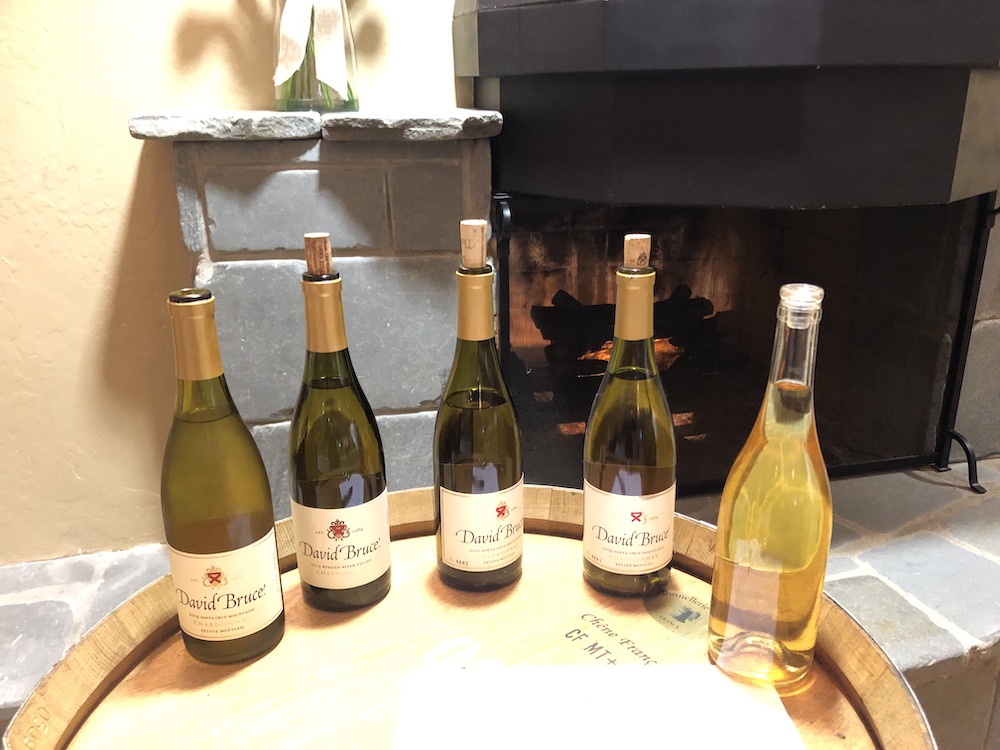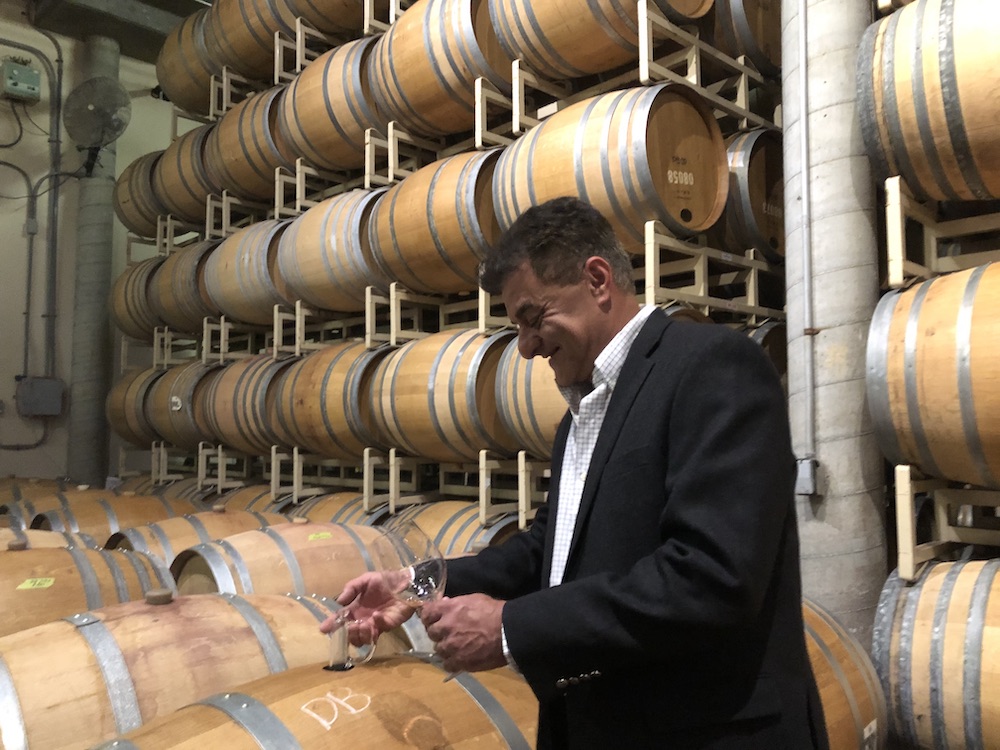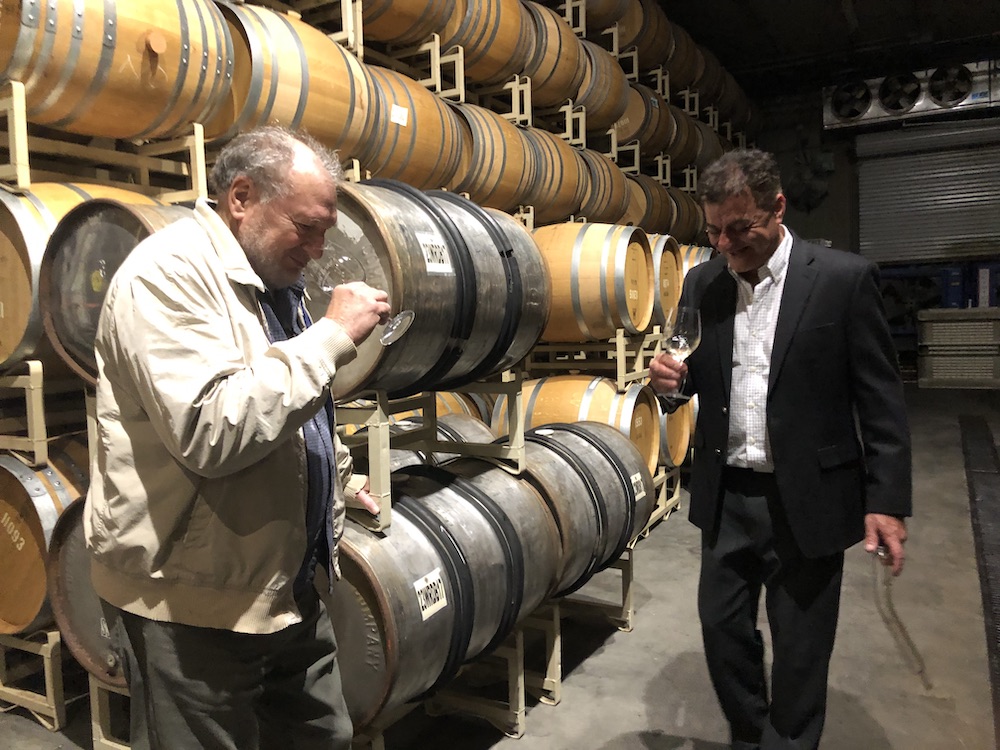
May 31, 2024 – Led by sales and hospitality director James Lovaas, the Chardonnay retrospective held at David Bruce Winery last weekend proved there is nothing like that forever impactful combination of dirt, elevation, sun exposure and proximity to ocean—known as terroir.
There were seven of us, including two recent club members, a couple who were former club members and hadn’t visited in years, a woman who had visited right after Dr. David had passed, a wine collector and former art gallery owner who drove over from Oakland and myself. My commute was the shortest; I live less than 2 miles from the winery.
Lovaas, who has both an MA and MBA from Liberty University, taught at Bethel University before beginning a career in the wine industry, including stints as GM at Reynolds Family Winery, director of operations at Tamber Bey and director of direct to consumer at Korbel before coming to David Bruce in February of this year. He clearly loves the educator role, and has the easy going, roll with the punches demeanor necessary to work in an unpredictable environment.
The retrospective was intended to pay homage to the wine, a 1973 Estate Chardonnay, made by Dr. David Bruce, which was submitted to the famous Judgement Of Paris in 1976. According to Lovaas, Bruce didn’t even know the wine had been part of that famous tasting and was surprised to suddenly find all kinds of wine collectors lined up outside the winery when news of the results was published.
Even though the David Bruce wine finished dead last, people were curious. For the very first time, California wines were on a world stage with French wines and California had shocked the wine critics, especially the French. The winner in the white wine category was actually a 1973 Chateau Montelena Chardonnay from Napa, followed by a French 1973 Mersault Charmes Roulot, with a 1974 Chalone Chardonnay taking third place on the podium. Pretty remarkable.
Winemaker Mitri Faravashi tried to recreate what that wine might have tasted like, going by the conversations he’d had with the dear Doctor before he passed away in 2021.
“Dr. David said that it was made with a portion of the vineyard that was prone to botrytis, adding a little sweetness to the wine,” said Faravashi. It was an interesting experiment. No wonder it placed last in 1976.
The same was true in this particular retrospective tasting. Far more compelling were the 2009, 2012 and 2019 Estate Chardonnays, all of which exhibited a depth and mouthfeel that can only come from the terroir of the Santa Cruz Mountains. The winery has long sourced both Chardonnay and Pinot Noir from other AVAs, including Santa Barbara and Edna Valley, as well as the Russian River, and while quite pleasurable, simply lack the depth and interest, at least to me, of the Estate wines.

Interestingly, we learned that the winery is attempting to buy back a vineyard it originally purchased in 1997 in the Sebastopol area of the Russian River; it was planted with the assistance of viticulture authority, Mark Greenspan, and subsequently sold to Young’s Market during a financial crunch. The current owner is not interested in letting go of it, so Faravashi says they are sourcing from a vineyard next door, which he finds has similar flavors. He also hinted that more Russian River Pinot Noir would be coming online in 2023, as Williams Selyem took less fruit than usual.
But back to the Chardonnays we tasted.
2009 Estate Chardonnay, Santa Cruz Mountains — A tad of oxidation yields aromas of roasted corn and apple fritters, with honeycomb, and flavors that are still strongly apple and oak dominated. Lovaas said that although he wouldn’t classify this as “over the hill,” it most certainly “knows where the hill is.” He also noted that “the 2010 found the hill at lot faster.” I was surprised at the lack of viscosity in this wine.
2012 Estate Chardonnay, Santa Cruz Mountains — This has a lovely nose, with pure butterscotch pudding and freshly fried doughnuts, turning to apple fritters and peach cobbler on the palate.
2015 Estate Chardonnay, Russian River — From the no longer owned by David Bruce Winery vineyard in Sebastopol, this one delivers sweet cream, dried apples and hazelnuts in the aromatics department, and adds burnt orange, tangerine and lots of toasty oak to the palate. The long finish is remarkable.
2019 Estate Chardonnay, Santa Cruz Mountains — Pleasing floral aromas combine with a tad of creamed corn and matchstick from the oak, then play to the citrus end of the flavor spectrum, finishing with sugar cookies and shortbread. This was the universal favorite of the group.
2021 Estate Chardonnay, Santa Cruz Mountains – Aromas of vanilla, butterscotch, Ritz crackers, popcorn and lemon curd, with flavors echoing the same notes. There’s very little fruit showing on this, as the oak is really dominating.
2022 Estate Chardonnay, Santa Cruz Mountains – From a barrel sample, we tasted a hint of what 2022 holds, and it is really no surprise that it is so decidedly tropical, given that it was a very warm summer with a big heat spike over Labor Day. Guava and papaya are the dominant flavors.
Faravashi says it’s interesting tasting with a variety of palates to see what younger consumers seem to want. “They want pure and simple: they don’t want a lot of oak or complexity. They don’t seem interested in aging wines.” This explains why they are sourcing from other areas, and doing tank ferments, to keep the Edna Valley and Santa Lucia Highlands Chardonnays distinctly different from the estate wines, which are barrel-fermented.

We next descended to the barrel room with Faravashi, learning that the Bear Creek Road winery, which is rated for 30,000 cases, now makes about 12,000 cases. (There are, however, 2,400 barrels in that cellar: no small task to manage with a skeleton crew.)
Prior to 2014, production was up to 60,000 cases, with a lot of the wines, including Petite Sirah, being made in Paso Robles. You may recall a time when you could easily find David Bruce wines in Trader Joes. Currently, the estate vineyard produces about 900 cases of Pinot Noir, 150 cases of Chardonnay and only 50 cases of Syrah. They are looking for that balance between direct to consumer and restaurant allocation.
Among the highlights of the barrel sampling, which were mostly from vintages 2022 and 2023, was the 2023 Estate Riesling, tasted from steel barrels rescued from a Coca Cola bottling plant, and ready to drink right now with no further fuss. It was lithe and fruity with plenty of candied lime and apricot and everything in the right place.
We also thrilled to try the 2023 Sangiovese from Gemelli Vineyard in Santa Clara, a screaming cherry fruit punch with plenty of acid and racy fruit. It could use a few months to settle down. The contrast of tannins in three Pinot Noirs we tasted showed that the David Bruce clone, planted at the highest point in the vineyard at over 2,200 feet, exhibited the biggest tannic bite. The 828 clone, aka La Tache, from Blocks 2 and 3, which run North/South, had pleasingly chalky tannins, with nice red fruit and a smack of salami.
Faravashi told us that most of the rows at the Estate are East/West orientation, which isn’t ideal for this particular spot, as the morning side gets too shadowed and the afternoon side can get too much sun. He prefers North/South row orientation.
I was particularly fond of the 2022 Martini Clone Estate Pinot Noir, planted in Block 1 of the vineyard, with its enticing cedar and sandalwood aromas, and fantastic texture. It has a prominent herbal component, and Faravashi says this comes from the vigor, i.e., leafiness, of the vines. But the tannins were quite agreeable.
We also tried the 2022 Estate Syrah, which is plenty meaty with ripe blackberry fruit, crushed pepper and very chewy tannins, doubtless amplified by 20 percent of whole cluster inclusion. After a year in bottle, it will likely be quite a fruit forward beast.
Lovaas said they are going to start doing vineyard hikes in June, and are planning a 60th anniversary BBQ on June 22, with live music. He also spoke of a very limited two barrel “Crown Jewel Pinot Noir” release to come this summer, in honor of Dr. David, who founded this place in 1964.
I suggest you sign up for their mailing list or wine club, to learn more.
I’ll leave you with a funny story that Foster Goldstrom shared with me via email:
“It was sometime in 2005 I was driving up from LA to Oakland through Ojai. I remember the scenes from the recent movie, “Sideways” at the Hitching Post restaurant. Hey, we should stop there and have dinner and some GREAT wine. We walked in to reach Nirvana. The guy tending the wine bar that evening was the first-prize winemaker of the year. Fantastic, can we try some of your creations? No, it’s it’s sold out! Well, what have you got to show me some greatness from the area? Right now we only have the 27 different Hitching Post wines. Oh, well, let me have your three best! The guy brings out those thick Libby glasses. Don’t you have some real wine glasses…no we don’t.
OMG, these wines are PLONK!
We sat down to dinner at a red checkerboard tablecloth and a waitress in a cowboy get-up, asked what we’d like. The Carte du Vin, please. What’s that? The sommelier, please…. What’s that? It’s the guy who knows something about wine. We got the BOOK with scads of offerings in the 200-500 price range for the recent local vintages. I was not about to plunk down serious money on wine I’d never heard of. The winemaker from the entrance came by the table and wanted to know if we needed some help and offered us a visit to his winery in the morning. $350 price range, but remember, sold out.
WAIT!!! I have a bottle of DAVID BRUCE, (2001?) Lucia Highlands Pinot in the car! We’ll have that! I brought it to the table and opened it. I was not about to drink one of my nectar of the Gods in a Libby wine glass. Could you find some Riedel stemware? Hey, the movie was made here and I recall they had used them. They searched and searched and came up with ONE Riedel cabernet glass. I smelled it and that the district aroma of commercial bathroom cleanser. This is a cab glass: we have a pinot noir here… go back and find a pinot glass. They finally came up with ONE stinky one, again, and I asked if they would be so kind as to wash it out. They did.
I offered him a taste.
OMG, this is incredible! Oh, Thank you!
We understood, that staying overnight and a visit to the winery would have been a waste of time. So we jumped in the car and drove directly home to Oakland, savoring our great DB.”
Talk about a night that went sideways in so many ways.
About the author
Laura Ness is a longtime wine journalist, columnist and judge who contributes regularly to Edible Monterey Bay, Spirited, WineOh.Tv, Los Gatos Magazine and Wine Industry Network, and a variety of consumer publications. Her passion is telling stories about the intriguing characters who inhabit the fascinating world of wine and food.
- Laura Nesshttps://www.ediblemontereybay.com/author/lness/
- Laura Nesshttps://www.ediblemontereybay.com/author/lness/
- Laura Nesshttps://www.ediblemontereybay.com/author/lness/
- Laura Nesshttps://www.ediblemontereybay.com/author/lness/


